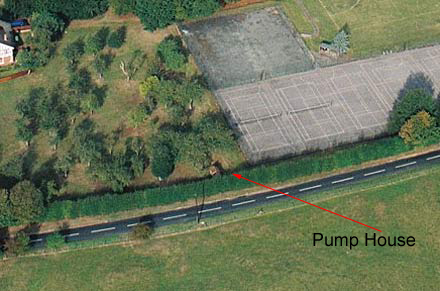The Pump House

The little building behind the centre of the replanted hedge is the former pump house,
which supplied water to the main house until the 1930s.
The original pump was a wind-driven pump with four anchor points in the ground: the angle iron was embedded in concrete, as can be seen in the right-hand picture which shows the remains of an anchor point at the corner of the hut. The hut itself was erected to cover the pump engine and machinery which replaced the wind-driven arrangement.
|
E. & H. ROBERTS, Ltd., Deanshanger Iron Works,
|
|
PRIZE MEDAL STEEL "HERCULES" WIND ENGINES.
|
|
The illustration below represents a 14-ft. Steel "Hercules" Wind Engine erected for the Rt. HON. LORD PENRHYN, to supply Wicken, a Northamptonshire Village containing 500 inhabitants, with water.
|
|
|
|
THE ABOVE MILL IS INCLUDED IN THE FOLLOWING TESTIMONIAL:
ESTATE OFFICE, WICKEN, STONY STRATFORD,
Sirs,
I have very much pleasure in stating that the three windmills you put up on the Wicken Estate have given very great satifaction.
Yours truly, LAURENCE CARTER,
Agent to Lord Penrhyn.
Special Lists and Prices on application.
|
|
STONY STRATFORD, England
|
Above is an advertisement from E.&.H Roberts Catalogue for the Hercules Windmill. E.& H. Roberts of Deanhanger were a local engineering company, supplying pumps to most of the surrounding estates in the late 19th century). Therefore it is presumed that this type of pump stood on the site before the pump house was built. Obviously the draw back with a wind pump is that if there wasn't any wind there wasn't any water.
The remains of the former pump driven by a small diesel engine inside the shed. Pumps of this type were known as "deep well" pumps. This particular pump was made by Duke Ockendon Limited of Littlehampton & London.
|

